
| Home | Deepsky Atlas | TheAstronews | Links | Solar System | ||||||

Hawaiian Astronomical SocietyConstellations: Cepheus -- Father of Andromeda |
||||||||||
Cepheus was the king of Ethiopia, father of Andromeda, and husband of Cassiopeia. For the detailed story, click here.
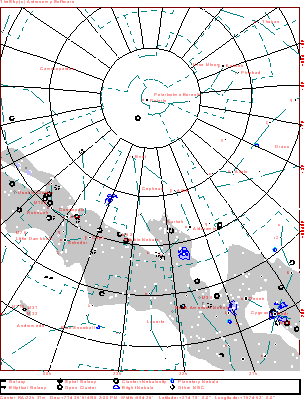
Click the map for a 909x1199 version of the above. Click here for a map better suited for use in the field.
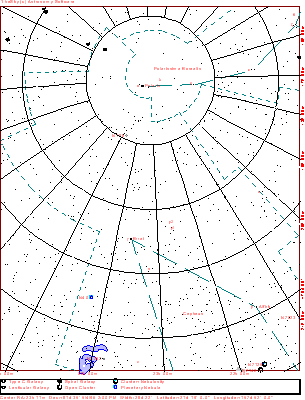
Click here for a map better suited for use in the field.
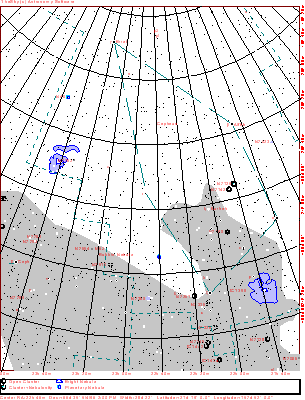
Click here for a map better suited for use in the field.
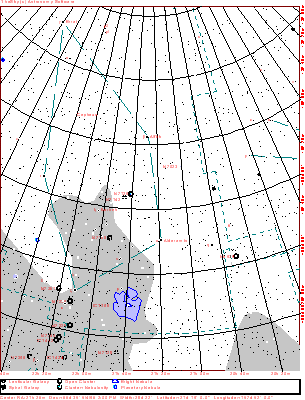
Click here for a map better suited for use in the field.
 62k JPEG NGC188 (Caldwell 1) is a mag. 8.1, large (14'), round, open cluster containing 150-200 stars. Located close to Polaris (just 4° south of it), it is the most northerly open cluster. From the Digital Sky Survey. 62k JPEG NGC188 (Caldwell 1) is a mag. 8.1, large (14'), round, open cluster containing 150-200 stars. Located close to Polaris (just 4° south of it), it is the most northerly open cluster. From the Digital Sky Survey.
|
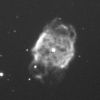 21k JPEG NGC40 (Best 19, Caldwell 2) is a mag. 11 planetary nebula described as very small (35"), bright in the center, with a mag. 12 central star. Image from the WIYN Observatory. 21k JPEG NGC40 (Best 19, Caldwell 2) is a mag. 11 planetary nebula described as very small (35"), bright in the center, with a mag. 12 central star. Image from the WIYN Observatory.
|
 83k JPEG NGC7380 is an open cluster with nebulosity located 2.3° east of Delta Cephei, and described as fairly large (12'), fairly rich (40 stars), little condensed, with stars ranging from mags. 9-13. The nebulosity responds to narrow band nebula filters. 83k JPEG NGC7380 is an open cluster with nebulosity located 2.3° east of Delta Cephei, and described as fairly large (12'), fairly rich (40 stars), little condensed, with stars ranging from mags. 9-13. The nebulosity responds to narrow band nebula filters.
The small cluster 1.5° to the lower, left (SE) is NGC7423. One of the non-existant NGCs, it actually does exist. Dreyer says it is very faint, fairly large, and not that hard to resolve.
Image is a mosaic from the Digital Sky Survey.
|
 19k JPEG Berkeley 94 is a nice open cluster located 1.6° SE of Epsilon Cephei. It shines at mag. 8.7, and contains 10 mag. 9.7 (and fainter) stars in a 4' area. They stand out nicely from the Cepheus Milky Way. From the Digital Sky Survey. The bright star is the mag 6.8 SAO34387. 19k JPEG Berkeley 94 is a nice open cluster located 1.6° SE of Epsilon Cephei. It shines at mag. 8.7, and contains 10 mag. 9.7 (and fainter) stars in a 4' area. They stand out nicely from the Cepheus Milky Way. From the Digital Sky Survey. The bright star is the mag 6.8 SAO34387.
|
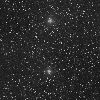 94k JPEG This is a nice, nameless star field in the Cepheus Milky Way, located 3.2° NNW of Lambda Cephei. It is described as similar to the Cygnus star cloud. Jeff Bondono recommends starting with Delta Cephei, and trending north, following the richest strip of stars. From the Digital Sky Survey. The upper (northern) bright star is 20 Cephei. The lower is 19 Cephei. 94k JPEG This is a nice, nameless star field in the Cepheus Milky Way, located 3.2° NNW of Lambda Cephei. It is described as similar to the Cygnus star cloud. Jeff Bondono recommends starting with Delta Cephei, and trending north, following the richest strip of stars. From the Digital Sky Survey. The upper (northern) bright star is 20 Cephei. The lower is 19 Cephei.
|
 43k JPEG NGC7160 is an open cluster located 4° east of Alderamin (Alpha Cephei), and described as poor (12 stars) and uncondensed (they cover 7'). Total magnitude is about 6, with stars mag. 7 and fainter. Located in a rich field, the cluster members stand out well from the background. From the Digital Sky Survey. The star in the upper right is the mag. 6.8 SAO19698. 43k JPEG NGC7160 is an open cluster located 4° east of Alderamin (Alpha Cephei), and described as poor (12 stars) and uncondensed (they cover 7'). Total magnitude is about 6, with stars mag. 7 and fainter. Located in a rich field, the cluster members stand out well from the background. From the Digital Sky Survey. The star in the upper right is the mag. 6.8 SAO19698.
|
 75k JPEG NGC7129 (Best 22) is a cluster with nebulosity located 4.3° NE of Alderamin (Alpha Cephei). The cluster in question lies to the upper, right (NW) in this image. Dreyer calls it a remarkable object. It is quite faint (mag. 11.5), fairly large (7'), with a gradually brightening middle of three stars. The associated, faint, fairly large (3') nebulosity is called NGC7133. NGC7142 is a cluster that lies 30' SE. Dreyer describes this as quite large (4.3'), quite rich (100 stars), fairly condensed, with stars at mags. 11-14. Image from the Digital Sky Survey. 75k JPEG NGC7129 (Best 22) is a cluster with nebulosity located 4.3° NE of Alderamin (Alpha Cephei). The cluster in question lies to the upper, right (NW) in this image. Dreyer calls it a remarkable object. It is quite faint (mag. 11.5), fairly large (7'), with a gradually brightening middle of three stars. The associated, faint, fairly large (3') nebulosity is called NGC7133. NGC7142 is a cluster that lies 30' SE. Dreyer describes this as quite large (4.3'), quite rich (100 stars), fairly condensed, with stars at mags. 11-14. Image from the Digital Sky Survey.
|
 172k JPEG IC1396 is an open cluster and nebulosity described as faint, and extremely large. It includes the open cluster listed as Trumpler 37. The nebulosity extends 165'x135'. The open cluster is 50'. The Cluster contains the double star Struve 2816. Image by Brad Wallis and Robert Provin. It was a two hour exposure taken through a 6", f7.5 refractor on 4"x5", hypered, Tech Pan 2415. 172k JPEG IC1396 is an open cluster and nebulosity described as faint, and extremely large. It includes the open cluster listed as Trumpler 37. The nebulosity extends 165'x135'. The open cluster is 50'. The Cluster contains the double star Struve 2816. Image by Brad Wallis and Robert Provin. It was a two hour exposure taken through a 6", f7.5 refractor on 4"x5", hypered, Tech Pan 2415.
|
 52k JPEG NGC7023 (Caldwell 4) is a mag. 7, reflection nebulosity, about 18' across. Dust areas are obvious in the photograph. Located 3.4° SW of Alfirk (beta Cephei). From the Digital Sky Survey. 52k JPEG NGC7023 (Caldwell 4) is a mag. 7, reflection nebulosity, about 18' across. Dust areas are obvious in the photograph. Located 3.4° SW of Alfirk (beta Cephei). From the Digital Sky Survey.
|
 99k JPEG Caldwell 9 (Sh2-155, also the Cave Nebula) faint emission nebula located 3.4° SSE of iota Cephei. With measurements of 50'x30' this object requires low power and a nebula filter. The narrow, northern crescent is the brightest portion. From the Digital Sky Survey. 99k JPEG Caldwell 9 (Sh2-155, also the Cave Nebula) faint emission nebula located 3.4° SSE of iota Cephei. With measurements of 50'x30' this object requires low power and a nebula filter. The narrow, northern crescent is the brightest portion. From the Digital Sky Survey.
|
 97k JPEG NGC6946 (Best 21, Caldwell 12, bottom left) is a very faint (mag. 9.9), very large (11.4'x9.8')spiral galaxy with a highly condensed nucleus. The prominent arms look granular in larger instruments. NGC6939 (Best 20) is a rich open cluster in the upper right of the photograph. Shining at mag. 7.8, individual stars are mags. 11-16. Its size is 8'. From the Digital Sky Survey. 97k JPEG NGC6946 (Best 21, Caldwell 12, bottom left) is a very faint (mag. 9.9), very large (11.4'x9.8')spiral galaxy with a highly condensed nucleus. The prominent arms look granular in larger instruments. NGC6939 (Best 20) is a rich open cluster in the upper right of the photograph. Shining at mag. 7.8, individual stars are mags. 11-16. Its size is 8'. From the Digital Sky Survey.
|
If you have any questions about the Hawaiian Astronomical Society
please
(link requires javascript).